INTRODUCTION
The Valley of Flowers nestled in the Himalayas sprawls over an area of about 87.50sqkms along with heart throbbing alpine flowers. The entire valley is in full bloom with different varieties of colourful flowers close to 500 species of wild flowers especially in the months June to October. The Valley of Flowers is one of the smallest National Park in the Himalayas, off the Rishikesh-Badrinath road and can be reached by a trek of 16kms from Govindghat.
The Valley of Flowers was mainly established as a reserve in the year 1982 mainly to safeguard the catchment area of the Pushpavati river which emerges from a glacier and flows down to join the Ganges. The natural geography is eye catching with the park being perched on the upper reaches of the Bhyundar Ganga and the Pushpawati River flowing by the valley with Rataban peak as its backdrop.
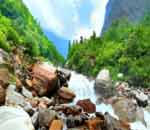
The Valley remains closed with snow during the months of winter. The beauty of this Valley was first unwielded by a British mountaineer, Franksmith in the year 1931.Enchanted by the picturesque beauty of the valley; he named it as 'Valley of Flowers�. There are references of this valley in the texts of Indian history and literature like that of Ramayana and Mahabharat.Though the park got established in the year 1982,only in July 2005 it was added to the list of World Heritage sites by UNESCO along with the Nanada Devi National Park. This World Heritage site with its virgin mystical beauty is of major attraction for the nature and adventure lovers.
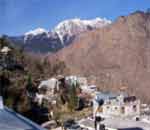
LOCATION
The Valley of Flowers National Park is situated in the upper expansions of Bhyundar Ganga near Joshimath in Gharwal region of Chamoli district. About 595 kilometers from Delhi, the altitude of the place varies from 3,200 m to 6,675 m.
BEST TIME TO VISIT
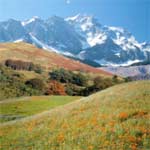
The ideal time to visit the Valley of Flowers is between the months of July to September, for the rest of the season it is covered with snow and block off the trail leading up to the National Park. During the season one can witness the valley with full of colourful blooms.
VALLEY OF FLOWERS OPENING HOURS
The park is open to the public only between 6 a.m. to 6 p.m.and the last entry is at 3 p.m.
ATTRACTION
FLORA
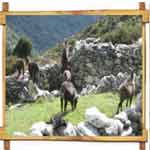
The Valley of flowers is in full bloom from July and goes for about the next three to four months. To add to this pristine beauty there are number of waterfalls along with the beautiful Pushpavati River. The valley by itself is alpine and there are at least some 300 species of flowers present here. These include Marsh Marigold, Lilium, Campanula, Pedicularis, Arisaema, Geranium, Bistorta, Ligularia, Epilobium, Rhododendrons, Corydalis, Inula, Braham Kamal, Cypripedium, etc.The flowers here with tremendous medicinal values are Anemone, Geranium, Marsh, Marigold, Primula, Potentilla, Geum, Aster. Lilium, Himalayan blue poppy, Aconite, Delphinium, Ranunculus, Corydalis, Inula, Saussurea Abvallata, Campanula. Pedicularis, Trysimum, Morina, Impetiens, Bistorta. Ligularia. Anaphalis Saxifraga, Lobelia, Thermophis, Trolises. Aquilogia, Codonopsis. Dactylorhiza and Cypripedium.
FAUNA
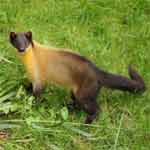
Though one cannot witness a major
wildlife here,the few
animals which can be spotted here are Himalayan Musk deer,
yellow throated Marten,
Snow Leopard,Himalayan Bear,Himalayan Mouse Hare,Musk Deer,Blue Sheep and Himalayan Tahr.There are many inscet varieties seen here especially different species of butterflies.
OTHER ATTRACTIONS
HEMKUND SAHIB
Hemkund Sahib is a popular spot to trek which is about a 19 km trek from Govindghat and at an altitude of about 4329 m.Apart from its picturesque surroundings; Hemkund is also an important pilgrim center for both Hindus and Sikhs. Close to the lake, the sacred Sikh Gurudwara and a Lakshman temple are located.
JOSHIMATH
Joshimath was established in the year 8th century by Adi Shankaracharya is one of the famous pilgrim centres in Uttrakhand where there are temples of Durga and Narsingh here. One can also trek from Joshimath to the Valley of Flowers.
BADRINATH
Badrinath, one of the holy places for Hindus in India. It is the most sacred Dham in India. Badrinath is located in the Chamoli district of Uttranchal, at around 3133 mts high from the sea level. Badrinath temple is dedicated to Hindu god Vishnu. This temple is near to the Alaknanda River.
ACCOMODATION AND EAT OUTS
It is not allowed to camp in the Valley of Flowers. The government runs Garhwal Mandal Vikas Nigam (GMVN) guesthouses are the reliable options for accommodations in the area, and advance bookings are possible. There are plenty of other options to choose from though. At Ghangaria you�ll find both basic hotels and camping facilities. There are state-run tourist rest houses at Joshimath and Ghangharia; both in addition, have several tourist lodges and resthouses.
GETTING THERE
BY AIR
The nearest airport is Jolly Grant, Dehradun (315 Km).
BY RAIL
The nearest railhead is at Rishikesh, 270 Km from Joshimath.
BY ROAD
Getting here requires a trek of about 20 Km. The nearest major town is Joshimath in Garhwal, which has convenient road connections from railheads such as Hardwar and Dehradun, both about 270 Km from Joshimath.From Joshimath, a vehicle can be hired to take you to within 17 km of the park, to the settlement of Gobindghat. The route from Joshimath to the Valley of Flowers goes along the main road to Badrinath; roughly midway along this road, a minor road branches off to Gobindghat, the roadhead for the Valley. From Gobindghat, a trek of 14 km brings hikers to the tiny settlement of Ghangaria, beyond which the toll gate to the National Park is about 3 km.
Travel Guide
Travel Information
 The Valley remains closed with snow during the months of winter. The beauty of this Valley was first unwielded by a British mountaineer, Franksmith in the year 1931.Enchanted by the picturesque beauty of the valley; he named it as 'Valley of Flowers�. There are references of this valley in the texts of Indian history and literature like that of Ramayana and Mahabharat.Though the park got established in the year 1982,only in July 2005 it was added to the list of World Heritage sites by UNESCO along with the Nanada Devi National Park. This World Heritage site with its virgin mystical beauty is of major attraction for the nature and adventure lovers.
The Valley remains closed with snow during the months of winter. The beauty of this Valley was first unwielded by a British mountaineer, Franksmith in the year 1931.Enchanted by the picturesque beauty of the valley; he named it as 'Valley of Flowers�. There are references of this valley in the texts of Indian history and literature like that of Ramayana and Mahabharat.Though the park got established in the year 1982,only in July 2005 it was added to the list of World Heritage sites by UNESCO along with the Nanada Devi National Park. This World Heritage site with its virgin mystical beauty is of major attraction for the nature and adventure lovers. 
 The ideal time to visit the Valley of Flowers is between the months of July to September, for the rest of the season it is covered with snow and block off the trail leading up to the National Park. During the season one can witness the valley with full of colourful blooms.
The ideal time to visit the Valley of Flowers is between the months of July to September, for the rest of the season it is covered with snow and block off the trail leading up to the National Park. During the season one can witness the valley with full of colourful blooms.
 The Valley of flowers is in full bloom from July and goes for about the next three to four months. To add to this pristine beauty there are number of waterfalls along with the beautiful Pushpavati River. The valley by itself is alpine and there are at least some 300 species of flowers present here. These include Marsh Marigold, Lilium, Campanula, Pedicularis, Arisaema, Geranium, Bistorta, Ligularia, Epilobium, Rhododendrons, Corydalis, Inula, Braham Kamal, Cypripedium, etc.The flowers here with tremendous medicinal values are Anemone, Geranium, Marsh, Marigold, Primula, Potentilla, Geum, Aster. Lilium, Himalayan blue poppy, Aconite, Delphinium, Ranunculus, Corydalis, Inula, Saussurea Abvallata, Campanula. Pedicularis, Trysimum, Morina, Impetiens, Bistorta. Ligularia. Anaphalis Saxifraga, Lobelia, Thermophis, Trolises. Aquilogia, Codonopsis. Dactylorhiza and Cypripedium.
The Valley of flowers is in full bloom from July and goes for about the next three to four months. To add to this pristine beauty there are number of waterfalls along with the beautiful Pushpavati River. The valley by itself is alpine and there are at least some 300 species of flowers present here. These include Marsh Marigold, Lilium, Campanula, Pedicularis, Arisaema, Geranium, Bistorta, Ligularia, Epilobium, Rhododendrons, Corydalis, Inula, Braham Kamal, Cypripedium, etc.The flowers here with tremendous medicinal values are Anemone, Geranium, Marsh, Marigold, Primula, Potentilla, Geum, Aster. Lilium, Himalayan blue poppy, Aconite, Delphinium, Ranunculus, Corydalis, Inula, Saussurea Abvallata, Campanula. Pedicularis, Trysimum, Morina, Impetiens, Bistorta. Ligularia. Anaphalis Saxifraga, Lobelia, Thermophis, Trolises. Aquilogia, Codonopsis. Dactylorhiza and Cypripedium.
 Though one cannot witness a major wildlife here,the few animals which can be spotted here are Himalayan Musk deer, yellow throated Marten,Snow Leopard,Himalayan Bear,Himalayan Mouse Hare,Musk Deer,Blue Sheep and Himalayan Tahr.There are many inscet varieties seen here especially different species of butterflies.
Though one cannot witness a major wildlife here,the few animals which can be spotted here are Himalayan Musk deer, yellow throated Marten,Snow Leopard,Himalayan Bear,Himalayan Mouse Hare,Musk Deer,Blue Sheep and Himalayan Tahr.There are many inscet varieties seen here especially different species of butterflies.


